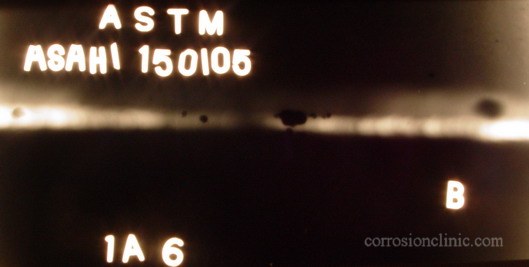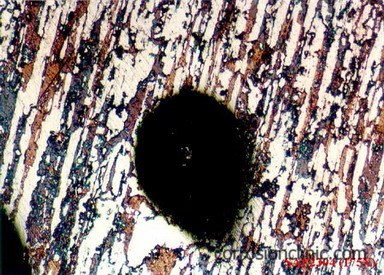|
 |
|
Home |
Consulting |
Training |
Expert Witness |
Failure Analysis |
Design Review |
Corrosion Test |
Corrosion Software |
Protective Coatings |
Materials Selection |
Cathodic Protection |
>>> |
|
|
Corrosion Diagnosis & Corrosion Failure
Analysis
|
|
 WebCorr has
NACE certified
Corrosion Specialist providing corrosion advisory and corrosion consulting services, in-house
corrosion training, online and distance learning
corrosion courses, corrosion diagnosis,
corrosion failure analysis and corrosion expert witness in litigation and arbitration cases
related to corrosion, materials, metallurgy, paints & metallic coatings including
thermal spray metallizing, galvanizing, anodizing, chromating, phosphating, electroless
plating, electroplating, mechanical plating, and sheradizing or diffusion coating. WebCorr has
NACE certified
Corrosion Specialist providing corrosion advisory and corrosion consulting services, in-house
corrosion training, online and distance learning
corrosion courses, corrosion diagnosis,
corrosion failure analysis and corrosion expert witness in litigation and arbitration cases
related to corrosion, materials, metallurgy, paints & metallic coatings including
thermal spray metallizing, galvanizing, anodizing, chromating, phosphating, electroless
plating, electroplating, mechanical plating, and sheradizing or diffusion coating.
-
Corrosion consultancy,
corrosion failure analysis, and trouble-shooting of materials and
corrosion related issues and
corrosion related issues
-
Professional
corrosion advisory services on corrosion failure avoidance and various
corrosion related issues.
-
Coatings failure analysis & paints failure analysis
-
Verification and measurements of seal quality and seal value of
anodized coatings using electrochemical impedance spectroscopy (EIS)
and equivalent circuit modeling.
-
Verification and assessment of surface preparation standard of
coated steel structure for its compliance with contract
-
Failure analysis and trouble-shooting of anodizing, chromating,
galvanizing, phosphating, electroplating and electroless plating
processes and metallic coatings.
-
Failure analysis of fasteners,
weldments, pipelines, vessels/tanks and various
equipment and structures.
-
Failure
analysis of corrosion resistant alloys (CRA) used in oil and gas,
petrochemical, refining, chemical processing, pharmaceutical, and
other industries.
-
Failure
analysis of stainless steels, duplex stainless steels and other
corrosion resistant alloys used in architectural applications.
-
Expert witness and support in litigation and arbitration
matters related to corrosion, materials, metallurgy, paints & metallic coatings including thermal spray metallizing, galvanizing,
anodizing, chromating, phosphating, electroplating, electroless
plating, mechanical plating, and sheradizing or diffusion coating.
Back to Top
Go to Examples
|
|
Typical Services Provided to Clients: |
|
|
-
Corrosion failure analysis of an aircraft engine AOC valve
-
Corrosion failure analysis of overhead power cables in a DC rail system
-
Corrosion failure analysis of a 316L stainless steel plug and seat valve used
in a chemical process plant
-
Corrosion expert witness in the corrosion of stainless steel assembly
-
Corrosion expert witness in corrosion of stainless cladding in buildings
-
Corrosion expert witness in the corrosion of stainless steel chains
-
Corrosion expert assistance in the corrosion of hot-rolled and cold-rolled steel
plates
-
Corrosion expert witness in the corrosion of silver coatings on mirrors
-
Corrosion expert witness in the corrosion of steel pipe piles
-
Corrosion expert witness in the corrosion of a lamppost
-
Expert assistance in electroless plating processes
-
Corrosion failure analysis of a galvanized roof in an
industrial area
-
Paint failure analysis of bus shelters
-
Corrosion failure analysis of military vehicles
-
Corrosion failure analysis of pinhole leaks in copper tubes in drinking water
distribution network
-
Corrosion failure analysis of hearing aids
Back to Top
|
|
Examples:
[1] [2]
[3] [4] |
| |
1. Failure Analysis of Underground Fuel Pipes
|
Sent: 16 September 2004 18:06
Subject: fuel pipe corrosion
We have 2 pipe sections that are leaked. They are made of API schedule
40 pipes and are of 8.1 mm thickness and 200 mm dia. The inputs we need
are as follows:
1. Did corrosion start from inside out or outside in?
2. The probable cause or causes which triggered the corrosion which led
to
the leak/failure i.e. the nature of the corrosion.
3. The likely period as to the initiation of the corrosion.
4. As for the other part of the section which appears to be in good
condition,
what would be the estimated remaining shelve life? Basically,
we would like
to determine whether this is an isolated incident or there is
"more" to come.
This is only the first stage of the inputs required. The second stage
study would require a non-destruction manner of assessing the overall
health state of the piping network. This would need to be discussed
further after the first stage is completed.
Thank you and regards
[name removed]
Back to Top
Back to Examples
|
|
2. Corrosion Analysis and Diagnosis
|
Sent: Wednesday, March 30, 2005 6:21 PM
Subject: Corrosion Analysis
We have a case whereby the customer�s pipes (Galvanized Steel Pipe, Mild
Steel Pipe) have signs of corrosion:
- Galvanized Steel Pipe show white rust (spots),
- Mild Steel Pipe show brown rust (spots),
- Painted (red) mild steel pipe show yellow patches.
All of them are being used (in service) in a chemical storage room. The
Galvanized Steel Pipe and unpainted Mild Steel Pipe are air ducts. The
painted mild steel pipe is the sprinkler system. These corrosion spots
are only observed within the room. The pipes run through another room
but no signs of corrosion were observed on the pipe in other rooms. We
are suspecting the air containing certain chemicals that are causing the
observed corrosion. The owner would like to know what chemicals are
causing the corrosion and how should the chemicals be stored upon
identifying the source of corrosion. Can we have your advice and
recommendations please?
Regards,
[name removed]
Back to Top
Back to Examples
|
|
3. Failure Analysis and Life Prediction
|
Sent: Tuesday, October 12, 2004 11:54 AM
Subject: CORROSION ANALYSIS OF BOLTS
I have the following case which will require your analysis. A tensile
test was conducted on the bolt. The sample fractured at the center where
the gasket was located instead of at the thread. The bolts were used on
manhole of a chemical storage tank. These tanks are fibreglass with PVC lining
inside. The Dia/Ht is 8 x 19.8 M. Design density is 1.25. Typical 33.4%
HCL density is abt 1.17. Machined bolt A4 SS316 for the manhole covers
with neoprene gasket were used. We wanted to know:
1. What caused the fracture of the bolt at the gasket area? (i.e.
embrittlement, crevice...)
2. What is the approximate lifespan of the bolt (or maintenance plan) if
they were to continue using stainless steel?
3. Any recommendation of a better material for the application?
Regards,
[name removed]
Back to Top
Back to Examples
|
|
4. Corrosion
Diagnosis
|
Date: Mon, 21 Aug 2006 03:12:51 -0700 (PDT)
Subject: Icon control panel corrosion
Photos of the corrosion are attached.
The corroded block is Nickle plated mild steel with stainless steel
plugs and fittings attached. All tubing and the reservoir are Stainless
Steel. The 3,000 psi MWP, pump body is Steel with Stainless Steel bolts
and mounting frame.
All paint is supposed to be, two-pak Epoxy with zinc base coat. The Blue
paint flaked off very easy indicating poor surface preparation. The
white Accumulators appeared to be well painted.
The installation is an Off-Shore drilling rig which may use caustic
chemicals. Although this area is not directly exposed to the fluid it
may be subject to; splash, spray or wash-down of the drilling fluids.
The unit itself is mounted approximately 20 meters above the Sea with an
ambient breeze of about 10 km.
I look forward to your diagnosis and hope to meet you,
Best Regards
[name removed]
Back to Top
Back to Examples |
|
Training Courses Related to Failure Analysis &
Prevention:
|
|
The following corrosion short courses are relevant to failure analysis and
prevention. They can be
conducted at any time for you as in-house training courses, online or distance-learning
courses. Public courses, seminars and workshops are also conducted
regularly. The contents and schedules of public short courses for the current year is
available
here.
|
|
|
|
|
Home
| Back to Top |
Contact
Us |
PDF |
Copyright © 1995-2025.
WebCorr Corrosion Consulting Services. All rights reserved. |

